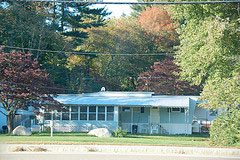
What may have come as a surprise, though, is how the practices highlighted in the article seem to be a replay of those that led to the larger housing crisis about 10 years ago—misleading loan terms, underwater homeowners and questionable practices that look a lot like steering.
The article also digs into many of the practices that CFED and its partners have highlighted as damaging to low- and moderate- manufactured homeowners—questionable sales practices, misleading lending terms, and expensive loan products—all of which can make a family’s key asset, their home, a depreciating one. For better or worse, Clayton is an obvious target for this type of journalism. It is an integrated company with a national footprint that makes about 40 percent of all manufactured home loans—and 45 percent of all the homes. For years, other lenders and retailers have operated in similar ways.
The article underscores why Congress and this Administration must hold fast on manufactured housing finance reform and not undercut the lending regulations that the Consumer Finance Protection Bureau (CFPB) implemented in early 2014. These rules have had about 15 months to work and there is little, if any, public evidence that access to credit has been hindered. Moreover, the CFPB has the authority to revisit the rules in response to market conditions and has decided not to do so.
CFED recently wrote about why the arguments for H.R. 650 and its Senate companion, S. 682, two bills to roll back protections for manufactured home buyers, are not supported by evidence and would be harmful to consumers, and why it is critical that we continue to work together to mainstream manufactured housing into the marketplace. Until owners of manufactured homes have the same broad rights and expectations in the housing marketplace, their homes will never be considered truly part of the affordable housing solution.
Ever since versions of these bills first appeared in Congress in 2012, insiders have argued that they are needed because the CFPB rules would be the death of the industry. That’s demonstrably untrue. Data from January 2015 show a one-year home production increase of 14 percent, suggesting the industry is finding new buyers. Furthermore, Berkshire Hathaway reported that Clayton experienced a remarkable 34 percent earnings growth in 2014.
These rules, some have argued, prevent lenders form making loans less than $20,000, due to high fixed costs. Yet the industry, in an apparent contradiction, recently introduced a new manufactured housing product, TruMH, which costs less than that magic threshold. (Yes, there are other fees that raise the final costs over $20,000, and there are cash sales, but it seems counterproductive to release a new product that does not fully support the industry’s lending arm, which is the real moneymaker in this space.)
No doubt in light of these trends, industry and its Congressional allies have retooled the talking points to claim that the legislative fix is aimed at helping low- and moderate-income homebuyers squeezed by nefarious Washington bureaucrats. To take this argument to its logical end, consumers would be better served if we simply return to the days of manufactured home lending in the shadows. Sadly, the experiences of the families highlighted in the Seattle Times/CPI story are such because they borrowed in the era before Congress introduced sunlight to this part of the housing world.
Another interesting part of this story is that in its response to the article, Clayton drew on an opinion piece (though Clayton frames it as news) by a law professor who has written very flattering books about Berkshire Hathaway and whose former firm represented a number of the companies Berkshire Hathaway acquired. This hardly looks like a neutral defender of the firm.
There is also no counter to the article’s statement that the loan failure rate for Vanderbilt is 33 percent and 26 percent for 21st Mortgage. Any rate approaching these figures seriously calls into question that the industry has a history of making safe loans. There should be, then, no surprise that advocates are alarmed that Congress may strip borrowers of desperately needed protections. This would just be a step backward.
Here’s the challenge that we face in this field: Even though manufactured homes can be part of the solution for housing throughout the United States, one key step to get there is to get everyone—zoning officials, grant makers, regulators, lenders, advocates and communities—to treat it the same as conventional housing.
When done fairly, with clear loans terms and solid construction, families receive a good deal on manufactured homes. We have models for how to get these things right. The first step is letting go of—and never returning to—the failed (business) models of the past.
(Photo credit: Flickr user Chris Devers, CC BY-NC-ND 2.0)





Comments